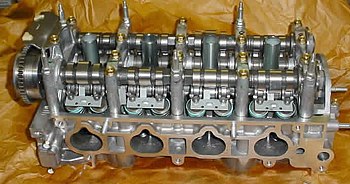
The Honda K-series engine is a line of four-cylinder four-stroke car engine introduced in 2001. The K-series engines are equipped with DOHC valvetrains and use roller rockers on the cylinder head to reduce friction. The engines use a coil-on-plug, distributorless ignition system with a coil for each spark plug. This system forgoes the use of a conventional distributor-based ignition timing system in favor of a computer-controlled system that allows the ECU to control ignition timings based on various sensor inputs. The cylinders have cast iron sleeves similar to the B- and F-series engines, as opposed to the FRM cylinders found in the H- and newer F-series engines found only in the Honda S2000.
Similar to B series, the K-series car engines have two short blocks with the same design; the only difference between them being the deck height. K20 uses the short block with a deck height of 212 mm (8.3 in) where K23 and K24 block has a deck height of 231.5 mm (9.1 in).[1]

Two versions of the Honda i-VTEC system can be found on a K-series engine, and both versions can come with variable timing control (VTC) on the intake cam. The VTEC system on engines like the K20A3 only operate on the intake cam; at low rpm only one intake valve is fully opened, the other opening just slightly to create a swirl effect in the combustion chamber for improved fuel atomization. At high engine speeds, both intake valves open fully to improve engine breathing. In engines such as the K20A2 found in the Acura RSX Type-S, the VTEC system operates on both the intake and exhaust valves, allowing both to benefit from multiple cam profiles. A modified K20C engine is used in motorsport, as the Sports Car Club of America Formula 3 and 4 series that run in North America both use a K20C engine, with the Formula 4 engine not having a turbocharger. These are gaining a following in the import scene, but also among hot rodders and kit car enthusiasts, because they can be put in longitudinal rear wheel drive layouts.
Another significant difference between K-series engines is the alignment of the crankshaft to the center line of the bore. The K20C1 engine block has an offset alignment.[2] Engines that do not have their crank shaft aligned to the bore are known as Desaxe engines. On the K20C1 engine this allows the power stroke to have more leverage and less thrust waste on sidewalls.
- ^ "Honda K-Series Engines". JDM Spec Engines. Archived from the original on 13 March 2014. Retrieved 20 May 2014.
- ^ "Civic Type R K20C1 Engine". Engine Builder Mag. Retrieved 23 June 2023.